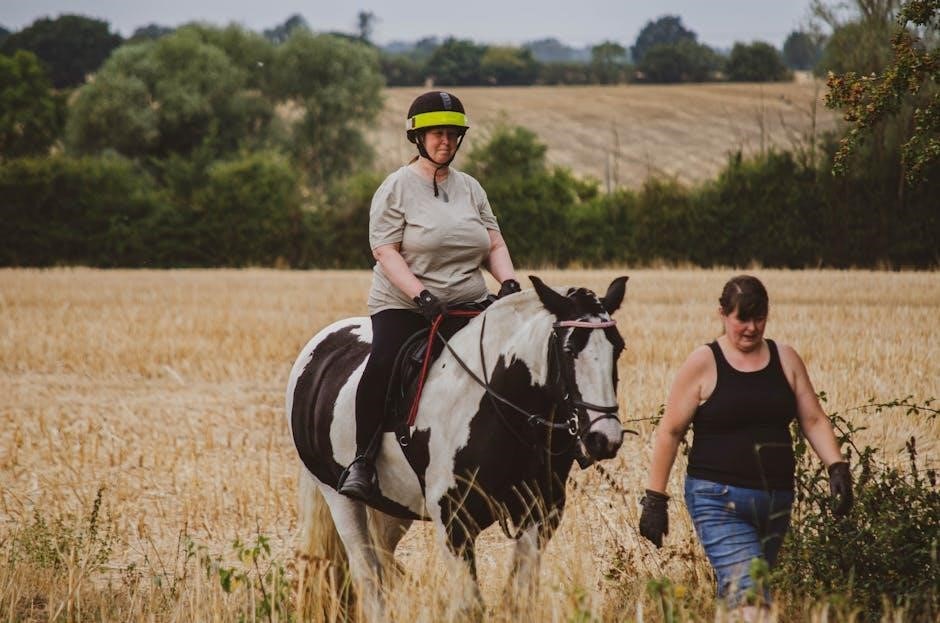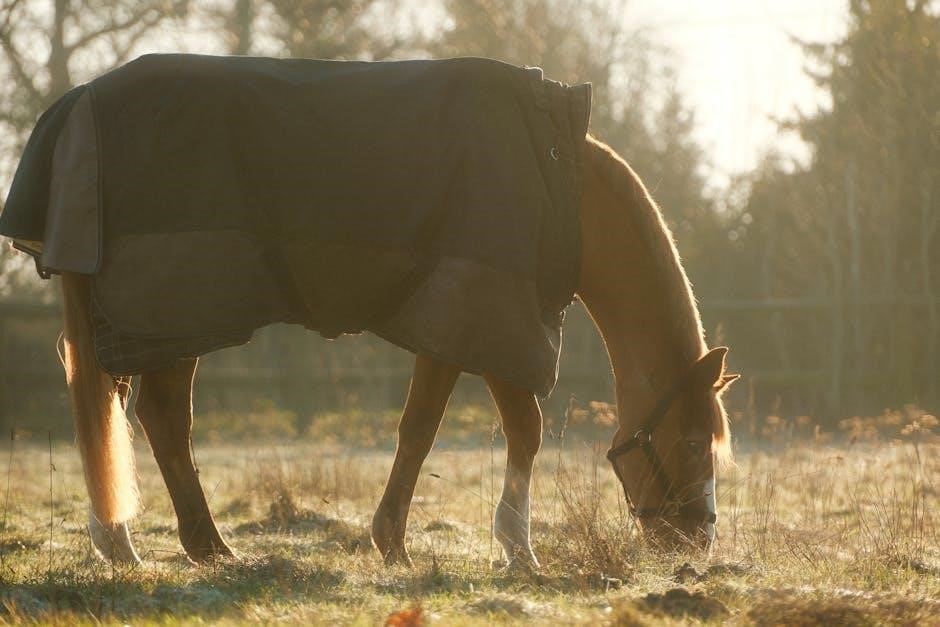Welcome to our guide! Choosing the right horse blanket size is crucial for your horse’s comfort and protection. Learn how to measure and select the perfect fit based on size‚ weight‚ and material to ensure optimal warmth and mobility during any season.

Measuring Your Horse for the Perfect Fit
Accurate measurements are essential for ensuring your horse’s blanket fits comfortably. Use a flexible tape measure from the center of the chest to the rear‚ ensuring proper coverage and mobility.
How to Determine Your Horse’s Blanket Size
To determine your horse’s blanket size‚ start by measuring from the center of the chest to the rear‚ just below the tail. This length ensures proper coverage. Consider your horse’s height and build‚ as taller or stockier horses may require additional length. A general rule is to add 30 cm to your horse’s height for the blanket size. For example‚ a 1.6m tall horse would need a 1.9m blanket. Always check the manufacturer’s size chart‚ as sizes can vary between brands. Ensure the blanket allows for shoulder movement and hindquarter comfort. Proper fit prevents rubbing and ensures your horse stays warm and comfortable during colder months. Accurate measurement is key to selecting the right size for optimal protection and mobility.
Step-by-Step Measuring Techniques
To ensure an accurate fit‚ follow these steps to measure your horse for a blanket:
- Use a flexible measuring tape and place it on the horse’s left side‚ starting from the center of the chest.
- Gently extend the tape to the rear‚ just below the horse’s tail‚ while maintaining a straight line.
- Ensure the tape is snug but not tight‚ allowing for a full range of motion.
- Record the measurement in centimeters or inches‚ depending on the manufacturer’s size chart.
- Consult the size guide provided by the blanket’s brand to match your measurement to the correct size.
- Double-check the fit by ensuring the blanket isn’t too tight around the shoulders or hindquarters.
Accurate measurement is crucial to ensure the blanket provides proper coverage and comfort for your horse‚ especially during colder months.

Factors Influencing Horse Blanket Size
Several factors influence the size of a horse blanket‚ ensuring proper fit and comfort. A horse’s breed‚ age‚ and body type play significant roles‚ as some breeds naturally have broader or narrower frames. The length and shape of the horse’s back‚ shoulder width‚ and hindquarter size also determine the ideal blanket size. Additionally‚ the horse’s neck length and whether it has a high or low wither can affect how the blanket sits. Clipped horses may require a slightly larger size due to increased sensitivity to cold; Understanding these factors helps in selecting a blanket that provides adequate coverage without restricting movement or causing discomfort. Always consider the horse’s individual characteristics when choosing a size.

Types of Horse Blankets and Their Sizes
Horse blankets vary in type‚ including turnout‚ stable‚ and lightweight options‚ each with specific size ranges to accommodate different breeds and body types.
Lightweight Blankets
Lightweight horse blankets are ideal for spring and fall seasons‚ providing protection without excessive warmth. They typically have no fill and are designed to shield your horse from rain and wind. These blankets are often waterproof‚ making them perfect for outdoor use in cooler‚ wet conditions. Sizes range from 4’0″ to 7’3″‚ catering to ponies and larger breeds. Lightweight blankets are a versatile option for horses that don’t need heavy insulation but still require protection from the elements. They are easy to handle and store‚ with breathable materials that prevent overheating. When choosing a lightweight blanket‚ consider your horse’s height‚ body type‚ and climate to ensure the right fit and functionality. Proper sizing ensures comfort and mobility‚ whether your horse is in the stable or pasture.
Medium-Weight Blankets
Medium-weight horse blankets are designed for cooler temperatures‚ typically between 25°F and 40°F‚ offering balanced warmth and protection. These blankets usually have a fill level of 200-300 grams‚ making them suitable for winter months when additional insulation is needed. They are versatile and can be used for both clipped and unclipped horses‚ depending on the climate. Medium-weight blankets are breathable yet durable‚ ensuring your horse stays comfortable without overheating. Sizes range from 4’0″ to 7’3″‚ accommodating ponies to larger breeds. When selecting a medium-weight blanket‚ consider your horse’s activity level‚ coat thickness‚ and the specific weather conditions they will be exposed to. Proper fitting is essential to ensure freedom of movement and prevent chafing. These blankets are a practical choice for horses needing consistent warmth during the colder seasons.
Heavyweight Blankets
Heavyweight horse blankets are designed for extreme cold weather‚ offering maximum warmth and protection. These blankets typically have a fill level of over 300 grams and are best suited for temperatures below 20°F. They are ideal for clipped horses in freezing conditions or unclipped horses in moderately cold climates. Many heavyweight blankets are both waterproof and breathable‚ ensuring durability and comfort. They are often used during harsh winter months when additional insulation is essential. Proper fitting is crucial to prevent chafing and ensure freedom of movement. Available in sizes from 4’0″ to 7’3″‚ heavyweight blankets cater to a wide range of horse breeds and sizes. Always consider your horse’s specific needs‚ such as activity level and coat type‚ when selecting a heavyweight blanket for optimal comfort and protection.

Determining the Right Blanket Weight
Blanket weight is crucial for your horse’s comfort. Lightweight (0-150g) suits mild weather‚ medium-weight (150-300g) for cooler conditions‚ and heavyweight (300g+) for freezing temperatures‚ ensuring warmth without restricting movement.
Temperature Guidelines for Blanket Weight
Choosing the right blanket weight is essential for your horse’s comfort‚ and it largely depends on the temperature. Here’s a general guide to help you decide:
- Lightweight Blankets (0-150g): Suitable for mild weather‚ typically when temperatures are above 50°F (10°C). Ideal for spring and fall seasons or for horses with a full winter coat.
- Medium-Weight Blankets (150-300g): Designed for cooler conditions‚ usually when temperatures range from 30°F (-1°C) to 50°F (10°C). These provide adequate warmth without being too heavy.
- Heavyweight Blankets (300g+): Best for freezing temperatures‚ often below 30°F (-1°C). These are ideal for harsh winters‚ especially for clipped horses or those that feel the cold more intensely.
Always consider your horse’s individual needs‚ such as their coat condition (clipped or unclipped) and personal comfort level. Adjust the blanket weight based on weather conditions‚ ensuring your horse stays warm but not overheated. Consult a veterinarian or equine professional for personalized advice.

How to Ensure the Blanket Fits Correctly
Ensure a proper fit by checking shoulder room and hindquarter alignment. Adjust the blanket to prevent restrictive movement while maintaining full coverage for optimal comfort and protection.
Checking Shoulder Room
Ensuring adequate shoulder room is essential for your horse’s comfort and mobility. A well-fitting blanket should allow for a full range of motion without restricting movement. To check the fit‚ place the blanket on your horse and observe how it sits across the shoulders. The blanket should lie smoothly‚ neither digging into the skin nor slipping excessively. If the blanket feels too tight‚ it may cause discomfort or rub sores‚ especially during movement. Conversely‚ a blanket that is too loose may shift position‚ leaving areas exposed. Adjust the fit by tightening or loosening the straps to achieve a snug yet comfortable position. Proper shoulder room ensures your horse can move freely‚ graze‚ and rest without irritation or constraint.
Ensuring Proper Hindquarter Fit
Proper hindquarter fit is crucial for your horse’s comfort and mobility. A well-fitting blanket should cover the hindquarters without restricting movement or causing pressure points. To ensure a proper fit‚ check that the blanket extends evenly over the horse’s rump and hips. The edges should lie flat against the horse’s skin‚ with no bunching or gapping. If the blanket is too tight‚ it may cause discomfort or chafing‚ especially during movement. If it’s too loose‚ it may shift position‚ leaving areas unprotected. Adjust the straps to ensure the blanket sits snugly but allows for a full range of motion. Proper hindquarter fit ensures your horse can move comfortably‚ whether in the stall or in the field‚ without irritation or constraint.

Materials and Their Impact on Sizing
Materials like polyester‚ nylon‚ and canvas affect sizing due to thickness and flexibility. Thicker fabrics may require a larger size for proper fit‚ while lightweight materials fit snugly‚ ensuring comfort and mobility for your horse.
Waterproof vs. Non-Waterproof Blankets
Waterproof blankets‚ often made from durable materials like polyester or nylon‚ are designed to protect your horse from rain and snow‚ making them ideal for outdoor use. Non-waterproof blankets‚ typically crafted from lighter fabrics such as cotton or fleece‚ are better suited for indoor use or milder weather conditions. The choice between the two depends on your horse’s lifestyle and climate. Waterproof blankets may require a slightly larger size to accommodate their bulkier design‚ while non-waterproof options fit more snugly. Consider your horse’s activity level and environment to select the most appropriate type. Proper fit ensures comfort and prevents chafing‚ regardless of the material. Always check the fabric’s breathability to avoid overheating‚ especially for active horses. This decision impacts both your horse’s comfort and the blanket’s longevity.
Selecting the right horse blanket involves careful consideration of size‚ weight‚ and material to ensure your horse stays comfortable and protected. Proper fit is essential to prevent chafing and restrict movement‚ while the right weight keeps your horse warm without overheating. Waterproof blankets are ideal for outdoor use‚ while non-waterproof options suit indoor settings. Always measure your horse accurately and choose materials that align with their needs. Regularly check the fit‚ especially as your horse’s size may change over time. By following this guide‚ you can make informed decisions to provide your horse with the best possible comfort and care throughout the year.
